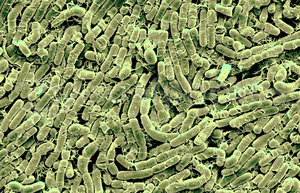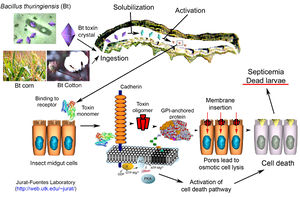Utilization of Bacillus thuringiensis in Genetically Modified Crops: Difference between revisions
| Line 2: | Line 2: | ||
[[Image:Green_Bacillus.png|thumb|300px|right|Figure 1. Scanning electron micrograph of a colony of <i>Bacillus thuringiensis</i> cells prior to sporulation. http://www.visualphotos.com/photo/1x3740021/bacillus-thuringiensis-bacteria-scanning-electron-micrograph-sem-of-bacillus-thuringiensis-colony-before-sporulation-microscope-magn-3000x-image-width-w-375-um-b-thuringiensis-is-used-as-biological-control-for.jpg]] | [[Image:Green_Bacillus.png|thumb|300px|right|Figure 1. Scanning electron micrograph of a colony of <i>Bacillus thuringiensis</i> cells prior to sporulation. http://www.visualphotos.com/photo/1x3740021/bacillus-thuringiensis-bacteria-scanning-electron-micrograph-sem-of-bacillus-thuringiensis-colony-before-sporulation-microscope-magn-3000x-image-width-w-375-um-b-thuringiensis-is-used-as-biological-control-for.jpg]] | ||
<br>By Zoë Frazier<br> | <br>By Zoë Frazier<br> | ||
<br> | <br> The bacterium <i>Bacillus thuringiensis</i> is a gram-positive and rod-shaped microbe that is 2¬–5 µm in length and 1.0 µm wide [9]. It is found in soil ecosystems, moist environments, and within caterpillar guts [5]. <i>Bacillus thuringiensis</i> is non-pathogenic for most organisms expect for a variety of insect species. <i>Bacillus thuringiensis</i> contains a gene that is known to code for Cry proteins. These proteins are produced during the sporulation phase of the <i>Bacillus thuringiensis</i> lifecycle. The Cry proteins are crystalline in structure and incredibly toxin to insects if consumed. The insect species that are killed by a variety of different <i>Bacillus thuringiensis</i> strains include vegetable insects (tomato and tobacco hornworms), field crop insects (European corn borers, alfalfa caterpillars and webworms), fruit crop insects (Leaf roller and Achemon sphinx), and tree insects (tent caterpillars, fall webworm, pine butterfly, Western spruce budworm). Additionally, mosquitoes, black flies, fungus gnats, cottonwood leaf beetles, elm leaf beetles, and Colorado potato beetles can also be affected if they consume the toxic Cry proteins [4]. | ||
< | Historically the Cry proteins produced by <i>Bacillus thuringiensis</i> have been used as a topical pesticide. However, due to advances in biotechnology, scientists have developed a mechanism to extract the Cry gene and insert it into another organism’s genome. The Cry gene is inserted into common crops that are in high demand, such as corn, wheat, cotton, canola, soy, and potato crops. Once the Cry gene is inserted into the genome, the plant can express its own insecticidal properties. This genetic alteration results in plants that are continuously producing pesticides, which helps to cut down or even eliminate the usage of spray-on pesticides. This new technological advancement is so popular in agriculture that by 2014, a total of 93% of all corn crops in the United States contained the Cry gene [3]. There are many different strains of <i>Bacillus thuringiensis</i>, all of which can be used to genetically modify plants to be resistant to specific target organisms. Despite the many seeming advantages to using genetically modified crops, there are several ecological effects that could drastically change the success rate of Bt crops. Both target organisms and secondary pests have been observed to adapt or evolve to resist the toxic effects of Bt crops. The following page will further describe the integration of <i>Bacillus thuringiensis</i> into our modern day agricultural system along with the social and ecological implications associated with the usage of this microbe. <br> | ||
< | |||
< | |||
< | |||
< | |||
< | |||
< | |||
==Structure and Phylogeny== | ==Structure and Phylogeny== | ||
Revision as of 00:56, 22 April 2015
Introduction

By Zoë Frazier
The bacterium Bacillus thuringiensis is a gram-positive and rod-shaped microbe that is 2¬–5 µm in length and 1.0 µm wide [9]. It is found in soil ecosystems, moist environments, and within caterpillar guts [5]. Bacillus thuringiensis is non-pathogenic for most organisms expect for a variety of insect species. Bacillus thuringiensis contains a gene that is known to code for Cry proteins. These proteins are produced during the sporulation phase of the Bacillus thuringiensis lifecycle. The Cry proteins are crystalline in structure and incredibly toxin to insects if consumed. The insect species that are killed by a variety of different Bacillus thuringiensis strains include vegetable insects (tomato and tobacco hornworms), field crop insects (European corn borers, alfalfa caterpillars and webworms), fruit crop insects (Leaf roller and Achemon sphinx), and tree insects (tent caterpillars, fall webworm, pine butterfly, Western spruce budworm). Additionally, mosquitoes, black flies, fungus gnats, cottonwood leaf beetles, elm leaf beetles, and Colorado potato beetles can also be affected if they consume the toxic Cry proteins [4].
Historically the Cry proteins produced by Bacillus thuringiensis have been used as a topical pesticide. However, due to advances in biotechnology, scientists have developed a mechanism to extract the Cry gene and insert it into another organism’s genome. The Cry gene is inserted into common crops that are in high demand, such as corn, wheat, cotton, canola, soy, and potato crops. Once the Cry gene is inserted into the genome, the plant can express its own insecticidal properties. This genetic alteration results in plants that are continuously producing pesticides, which helps to cut down or even eliminate the usage of spray-on pesticides. This new technological advancement is so popular in agriculture that by 2014, a total of 93% of all corn crops in the United States contained the Cry gene [3]. There are many different strains of Bacillus thuringiensis, all of which can be used to genetically modify plants to be resistant to specific target organisms. Despite the many seeming advantages to using genetically modified crops, there are several ecological effects that could drastically change the success rate of Bt crops. Both target organisms and secondary pests have been observed to adapt or evolve to resist the toxic effects of Bt crops. The following page will further describe the integration of Bacillus thuringiensis into our modern day agricultural system along with the social and ecological implications associated with the usage of this microbe.
Structure and Phylogeny
Include some current research, with at least one figure showing data.
History
Include some current research, with at least one figure showing data.
Life Cycle
Figure 2.
Bt Toxins

Figure 3.
Bt Crops

Figure 4.
Ethical Issues Surrounding Bt Crops
Include some current research, with at least one figure showing data.
Evolved Resistance and Secondary Pests

Figure 5.
Conclusion
Include conclusion
References
[1] Aeschbacher, K., Messikommer, R., Meile, L. & Wenk, C. (2005). Bt176 Corn in Poultry Nutrition: Physiological Characteristics and Fate of Recombinant Plant DNA in Chickens. Poultry Science Association, 84, 385 – 394.
[2] Catarino, R., G. Ceddia, F.J. Areal, and J. Park. (2015). The impact of secondary pests on Bacillus thuringiensis (Bt) crops. Plant Biotechnology Journal, 1-12.
[3] Cheeke, T.E., U.M. Schütte, C.M. Hemmerich, M.B. Cruzan, T.N. Rosenstiel, and J.D. Bever. (2015). Spatial soil heterogeneity has a greater effect on symbiotic aburscular mycorrhizal fungal communities and plant growth than genetic modification with Bacillus thuringiensis toxin genes. Molecular Ecology, 1-33.
[4] Cranshaw, W.S. Bacillus thuringiensis: Fact Sheet No. 5.556. Insect Series, Home and Garden. Colorado State Univserity.
[5] de Maagd, R.A. 2015. Chapter 20: Bacillus thuringiensis- Based Products for Insect Pest Control. Principles of Plant-Microbe Interactions. Springer International Switzerland, 2015. 185-192.
[6] Finucane, M.L. & J.L. Holup. (2005). Psychosocial and cultural factors affecting the perceived risk of genetically modified food: an overview of the literature. Social Science & Medicine, 60, 1603 – 1612.
[7] Gassmann, A.J. J.L., Petzold-Maxwell, E.H. Clifton, M.W. Dunbar, A.M. Hoffmann, D.A. Ingber, and R.S. Keweshan. (2014). Field-evolved resistance by western corn rootworm to multiple Bacillus thuringiensis toxins in transgenic maize. PNAS, 111(14), 5141-5146.
[8]Hansen Jesse, L.C. & J.J. Obrlycki. (2000). Field deposition of Bt transgenic corn pollen: lethal effects on the monarch butterfly. Oecologia, 125, 241 – 248.
[9] Ibrahim, M.A., N. Griko, M. Junker, and L.A. Bulla. 2010. Bacillus thuringiensis: A genomic and proteomics perspective. Bioengineered Bugs 1:1, 31-50.
[10] Jurat-Fuentes, J.L. "What Is Bacillus Thuringiensis (Bt)?" Bt Mode of Action. The University of Tennessee Institute of Agriculture. Web. <http://web.utk.edu/~jurat/Btresearchtable.html>.
[11] Petras, S.F. and L.E. Casida. (1985). Survival of Bacillus thuringiensis Spores in Soil. Applied and Environmental Microbiology, 59, 1496 – 1501.
[12] Uzogara, S.G. (2000). The impact of genetic modification of human foods in the 21st century: A review. Biotechnology Advances, 18, 179 – 206.

